【知识学习】七年级上册 Unit4 My Day复习教案
- 格式:doc
- 大小:19.00 KB
- 文档页数:10
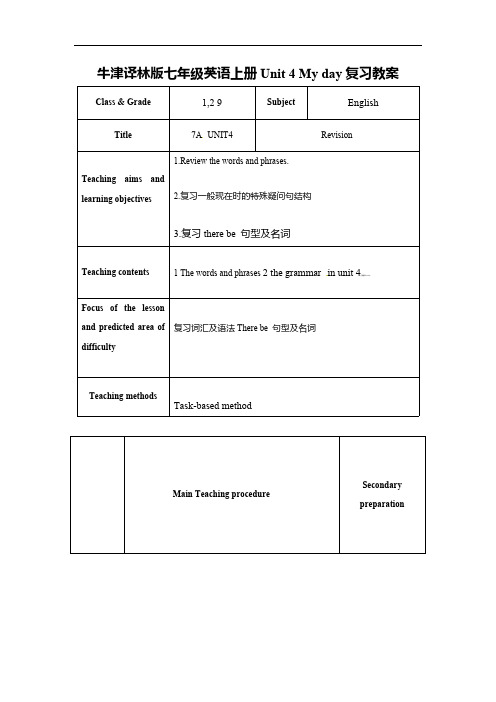
牛津译林版七年级英语上册Unit 4 My day复习教案Class & Grade1,2 9Subject English Title7A UNIT4RevisionTeaching aims and learning objectives 1.Review the words and phrases.2.复习一般现在时的特殊疑问句结构3.复习there be 句型及名词Teaching contents 1 The words and phrases 2 the grammar in unit 4来源:Z#xx#kFocus of the lessonand predicted area ofdifficulty复习词汇及语法There be 句型及名词Teaching methodsTask-based methodMain Teaching procedureSecondarypreparationTeaching procedure Step1. revise oral English背口语书上第十一篇。
Step2.Revise Grammar and phrases.一.单词解释(语法):1.)story/factory/shelf/knifetomato/mango/potato上述名词的复数形式是?其变化规律是?2.)变累/感觉更好/尝起来甜(系表结构)be tired/feel better/taste sweet3.)两公斤肉/两玻璃杯水two kilos of meattwo glasses of waterQuestion:如何计量不可数名词?three big pieces of papertwo cups of teaa loaf of breadtwo bottles of orange(a cold drink)4)表示动作频率的副词/短语:never,seldom,sometimes,often,usually, alwaysmany times a day,twice a week,30hours a week,every day,3or6times a weeke.g.你常吃蛋糕、饼干和糖?很少吃。

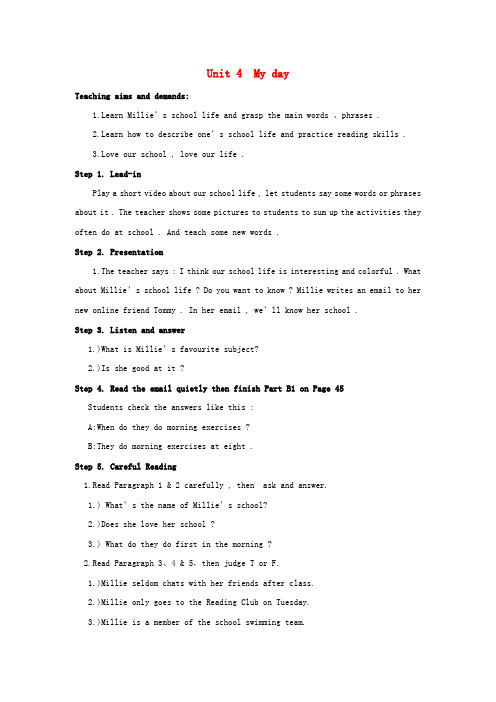
Unit 4 My dayTeaching aims and demands:1.Learn Millie’s school life and grasp the main words 、phrases .2.Learn how to describe one’s school life and practice reading skills .3.Love our school , love our life .Step 1. Lead-inPlay a short video about our school life , let students say some words or phrases about it . The teacher shows some pictures to students to sum up the activities they often do at school . And teach some new words .Step 2. Presentation1.The teacher says : I think our school life is interesting and colorful . What about Millie’s school life ? Do you want to know ? Millie writes an email to her new online friend Tommy . In her email , we’ll know her school .Step 3. Listen and answer1.)What is Millie’s favourite subject?2.)Is she good at it ?Step 4. Read the email quietly then finish Part B1 on Page 45Students check the answers like this :A:When do they do morning exercises ?B:They do morning exercises at eight .Step 5. Careful Reading1.Read Paragraph 1 & 2 carefully , then ask and answer.1.) What’s the name of Millie’s school?2.)Does she love her school ?3.) What do they do first in the morning ?2.Read Paragraph 3、4 & 5,then judge T or F.1.)Millie seldom chats with her friends after class.2.)Millie only goes to the Reading Club on Tuesday.3.)Millie is a member of the school swimming team.Step 6. Play a gameStep 7. PracticeComplete Millie's school life .(方框选词填空)in the afternoon, have a good time, chat with,play in the playground, practise, nice ,start,Millie is a new student at Sunshine Middle School . Her school ________at 8:00in the morning . Millie has a lot of friends at School . They are all ______ toher . After class , they often _____________ each other or _____________________. Sometime she goes to the library________________. She often reads books in the Reading Club . She also likes playingvolleyball. She is a member of the school volleyball team.She ___________ afterschool on Wednesday afternoon . She always_______________ at her school.Step 8. ConsolidationGroup work: Can you talk about your school life .Student1 : School and lessonsStudent2 : Friends at schoolStudent3 : HobbiesStudent4 : After-school activitiesStudent5 : FeelingStep 9. Watch and discuss1.)What's the differences between our school and theirs ?2.)What do you think of their school life ?3.)What should we do ?Step 10. Homework1.Read and recite Millie’s email.2. Write something about your school life in English and then talk about it withyour classmates.【课后拓展】阅读理解:Hi. I’m LingLing. I’m a studen t at No. 14 Secondary School. Do you want to knowmy life? Let me tell you about it. I usually get up at 7:00 in the morning. I have my breakfast at 7:10. My parents always prepare(准备)the breakfast for me. I go to school at 7:30. We have 7 lessons every day f rom Monday to Friday. I like English lesson very much. After school, I like playing ping-pong and basketball with my friends. There is a very big playground in our school.( )1. I have my br eakfast at ______.A. 7:00B. 7:10C. 7:30D.7:20( )2. I have seven lessons ____.A. every dayB. at the weekendC. five days a weekD. twice a week( )3. I like ______ very much.A. EnglishB. ChineseC. art lessonD. all lessons( )4. There is a big ______ in No. 14 Secondary School.A. gardenB. libraryC. playgroundD. computer room( )5. I li ke playing ______ with my friends.A. ping-pong and basketballB. footballC. football and basketballD. basketball。
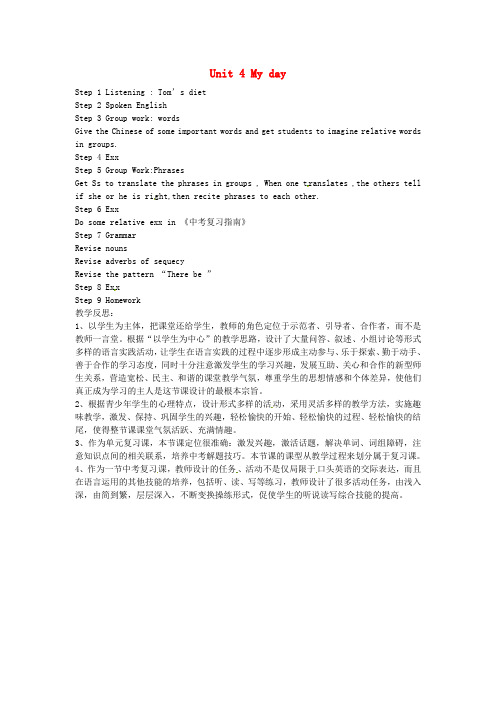
Unit 4 My dayStep 1 Listening : Tom’s dietStep 2 Spoken EnglishStep 3 Group work: wordsGive the Chinese of some important words and get students to imagine relative words in groups.Step 4 ExxStep 5 Group Work:PhrasesGet Ss to translate the phrases in groups , When one t ranslates ,the others tell if she or he is right,then recite phrases to each other.Step 6 ExxDo some relative exx in 《中考复习指南》Step 7 GrammarRevise nounsRevise adverbs of sequecyRevise the pattern “There be ”Step 8 Ex xStep 9 Homework教学反思:1、以学生为主体,把课堂还给学生,教师的角色定位于示范者、引导者、合作者,而不是教师一言堂。
根据“以学生为中心”的教学思路,设计了大量问答、叙述、小组讨论等形式多样的语言实践活动,让学生在语言实践的过程中逐步形成主动参与、乐于探索、勤于动手、善于合作的学习态度,同时十分注意激发学生的学习兴趣,发展互助、关心和合作的新型师生关系,营造宽松、民主、和谐的课堂教学气氛,尊重学生的思想情感和个体差异,使他们真正成为学习的主人是这节课设计的最根本宗旨。
2、根据青少年学生的心理特点,设计形式多样的活动,采用灵活多样的教学方法,实施趣味教学,激发、保持、巩固学生的兴趣,轻松愉快的开始、轻松愉快的过程、轻松愉快的结尾,使得整节课课堂气氛活跃、充满情趣。
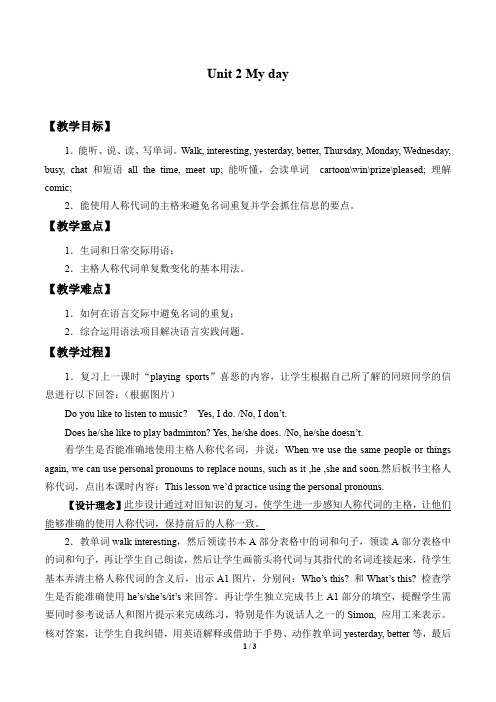
Unit 2 My day【教学目标】1.能听、说、读、写单词。
Walk, interesting, yesterday, better, Thursday, Monday, Wednesday, busy, chat和短语all the time, meet up; 能听懂,会读单词cartoon\win\prize\pleased; 理解comic;2.能使用人称代词的主格来避免名词重复并学会抓住信息的要点。
【教学重点】1.生词和日常交际用语;2.主格人称代词单复数变化的基本用法。
【教学难点】1.如何在语言交际中避免名词的重复;2.综合运用语法项目解决语言实践问题。
【教学过程】1.复习上一课时“playing sports”喜恶的内容,让学生根据自己所了解的同班同学的信息进行以下回答:(根据图片)Do you like to listen to music? Yes, I do. /No, I don’t.Does he/she like to play badminton? Yes, he/she does. /No, he/she doesn’t.看学生是否能准确地使用主格人称代名词,并说:When we use the same people or things again, we can use personal pronouns to replace nouns, such as it ,he ,she and soon.然后板书主格人称代词,点出本课时内容:This lesson we’d practice using the personal pronouns.【设计理念】此步设计通过对旧知识的复习,使学生进一步感知人称代词的主格,让他们能够准确的使用人称代词,保持前后的人称一致。
2.教单词walk interesting,然后领读书本A部分表格中的词和句子,领读A部分表格中的词和句子,再让学生自己朗读,然后让学生画箭头将代词与其指代的名词连接起来,待学生基本弄清主格人称代词的含义后,出示A1图片,分别问:Who’s this? 和What’s this? 检查学生是否能准确使用he’s/she’s/it’s来回答。
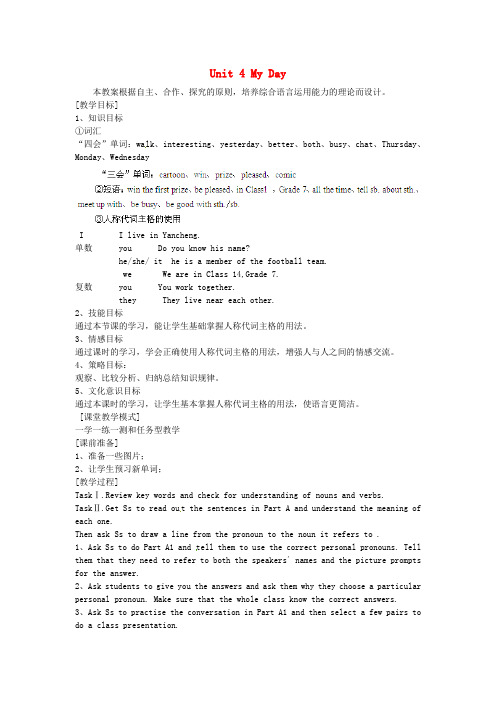
Unit 4 My Day本教案根据自主、合作、探究的原则,培养综合语言运用能力的理论而设计。
[教学目标]1、知识目标①词汇“四会”单词:walk、interesting、yesterday、better、both、busy、chat、Thursday、Monday、WednesdayI I live in Yancheng.单数 you Do you know his name?he/she/ it he is a member of the football team.we We are in Class 14,Grade 7.复数 you You work together.they They live near each other.2、技能目标通过本节课的学习,能让学生基础掌握人称代词主格的用法。
3、情感目标通过课时的学习,学会正确使用人称代词主格的用法,增强人与人之间的情感交流。
4、策略目标:观察、比较分析、归纳总结知识规律。
5、文化意识目标通过本课时的学习,让学生基本掌握人称代词主格的用法,使语言更简洁。
[课堂教学模式]一学一练一测和任务型教学[课前准备]1、准备一些图片;2、让学生预习新单词;[教学过程]TaskⅠ.Review key words and check for understanding of nouns and verbs.TaskⅡ.Get Ss to read ou t the sentences in Part A and understand the meaning of each one.Then ask Ss to draw a line from the pronoun to the noun it refers to .1、Ask Ss to do Part A1 and tell them to use the correct personal pronouns. Tell them that they need to refer to bo th the speakers´ names and the picture prompts for the answer.2、Ask students to give you the answers and ask them why they choose a particular personal pronoun. Make sure that the whole class know the correct answers.3、Ask Ss to practise the conversation in Part A1 and then select a few pairs to do a class presentation.TaskⅢ. Ask Ss to look at the sentences in Part A2 and to complete the sentences on their own. Then check answers with the whole class.TaskⅣ. Ss read the article in Part A3 for general understand only. Give a quick explaination of any words they do not know. Ask Ss to complete the task on their own. Then read the article to the class. Try to deal with all the problems after reading the article in order to maintain the students’ int erest.TaskⅤ. Extension activityAsk students to u nderline all the personal pronouns(subject form)in the reading passase on page20.TaskⅥ. Practice—Task. 课堂教学任务目的:比较熟练掌握人称代词主格的用法材料:挂图语言技能:Peading and speaking活动形式:Groupwork/Pairwork操作过程:①两人一组到前面表演②分小组形式进行讨论。
tudents’ own day.1. New words and phrases: wake, wake up, shall, hill, seldom, out, go out, need, rest, III. Focus of the lesson and predicted area3. Read aloud after the tape and learn t he language points.What/How about doing …? = Why don’t we do …? need se1. Listen to the conversati on in Part B and plete the table.start lessonsat a quarter past eightenjoy schoolT: OK, do you have any questions to ask me? “I’m never late for it.” Who can translate it into Chinese? What does “never” mean?4. Develop the conversation.【设计意图:通过书上提供的表格进行扩展练习。
】Step 2 Consolidation1. plete the passage, check the answers and read the passage aloud.T: OK, you really did a good job. Now are you clear abou t Millie’s daily activities? Please plete this short passage about Millie’s day.Millie is a hard-working student. She ______ up early in the morning. She goes to _______ at 7:20. She’s _______ late for school. Before the first lesson starts, Millie and all her classmates do morning ________. She has lunch at ten to ________. The school finishes at four ______ in the afternoon. Then it’s time for after-school ________. She always has fun. In the evening, Millie watches TV for ______ an hour. It’s her favourite time of the day. Then she needs to do her __________. She always does it carefully. She usually goes to _______ at 9:30.2. Report your day.(1) plete the table in the book abo ut the students’ own days.T: Now, I know something about Eddie’s and Millie’s days now. Next, I’d like to know about your day. Please write down the time and the activities in the table.(2) Practice reporting the students’ own da ys.T: OK, p lease try to report your day according to the table you finished just now. I’ll give you only two minutes to practice. Please try to make your report clear and interesting.(3) Ask a student to report and the other students to listen carefully.T: Time is up! Are you ready to report your day? When one student is telling about his or her day, the others should listen carefully. I will ask you questions after the report. Who’d like to be the first to tell us about your day?T: Thank … for your report. Now q uestions for the other students. Are you ready? Question 1 …【设计意图:让学生结合自己的实际情况练习,达到学以致用。
牛津译林版七年级英语上册Unit 4 My day知识点复习教案一、同步知识讲解Part 1 Comic Strip &Welcome to the unit1. Wake up, Eddie!(P 42)wake 现在分词_____________ 过去式_____________wake up _____________1) wake 常作及物动词,意为“_____________”。
【翻译】请在七点叫醒我。
_______________________________________2) wake作不及物动词,意为“_____________”。
【翻译】当他醒了的时候请告诉他这个新闻。
_______________________________________ Keys: wake 现在分词waking 过去式wokewake up 叫醒,醒来1) wake 常作及物动词,意为“使醒来,唤醒”。
【翻译】Please wake me up at seven o’clock.2) wake作不及物动词,意为“醒,醒来”。
【翻译】When he wakes up, please tell him the news.批注:当wake up意为“叫醒” 时,要注意宾语的位置。
如果宾语是人称代词,通常位于wake和up之间。
如果宾语是名词,则既可位于wake和up之间,也可位于wake up之后。
如:Please wake me up at 6:00 a.m. tomorrow morning.(但不可说wake up me。
) Don’t wake up your dad.= Don’t wake your dad up.2. Is it time for breakfast? (P42)【同义句转换】该吃晚饭了。
It's time to _________ __________. 或者:It's time ____________ ____________.Keys:have supper ;for supper批注:“Its’ time to...”和“It’s time for ...”是两个固定句型,其中it均指现在的时间,而time后的词是用to还是for要根据其后的词性判断。
七年级上册 Unit4 My Day复习教案七年级上册 Unit4 My Day复习教案一、重点单词 wake v. 唤醒;醒 start v. 开始,着手 seldom adv. 很少,不常 quarter n.一刻钟 usually adv. 通常,经常 practise v. 练习,训练= practice activity n. 活动 never adv. 从不,绝不二、重点单词、语句讲解 1、wake up 叫醒,醒来(1)wake 常作及物动词,意为“使醒来,唤醒” Please wake me up at seven o’clock. (2)wake作不及物动词,意为“醒,醒来” He woke three times during the night. ①当wake up意为“叫醒”时,要注意宾语的位置。
如果宾语是人称代词,通常位于wake和up之间。
Please wake me up at 6:00 a.m. Tomorrow morning. ②如果宾语是名词,则既可以位于wake和up之间,也可以位于wake up之后。
Don’t wake up your dad.=Don’t wake your dad up. On Father’ Day, I will give my father some presents as soon as he _________. A. stay up B.wakes up C.got up D.put up 2、It’s time to+动词短语It’s time for +名词e.g It’s time to have breakfast.=It’s time for breakfast.3、sleep n./v. 睡觉(1)She doesn’t get much sleep.她睡眠不足。
I sleep 8 hours every day.我每天睡八个小时。
七年级上册 Unit4 My Day复习教案
课
件www.5yk
七年级上册Unit4myDay复习教案
一、重点单词
wakev.唤醒;醒
startv.开始,着手
seldomadv.很少,不常
quartern.一刻钟
usuallyadv.通常,经常
practisev.练习,训练=practice
activityn.活动
neveradv.从不,绝不
二、重点单词、语句讲解
、wakeup叫醒,醒来
(1)wake常作及物动词,意为“使醒来,唤醒”Pleasewakemeupatseveno’clock.
(2)wake作不及物动词,意为“醒,醒来”Hewokethreetimesduringthenight.
①当wakeup意为“叫醒”时,要注意宾语的位置。
如果宾语是人称代词,通常位于wake和up之间。
Pleasewakemeupat6:00a.m.Tomorrowmorning.
②如果宾语是名词,则既可以位于wake和up之间,也可以位于wakeup之后。
Don’twakeupyourdad.=Don’twakeyourdadup.
onFather’Day,Iwillgivemyfathersomepresentsassoonashe________ _.
A.stayup
B.wakesup
c.gotup
D.putup
2、It’stimeto+动词短语
It’stimefor+名词
e.gIt’stimetohavebreakfast.=It’stimeforbreakfast.
3、sleepn./v.睡觉
(1)Shedoesn’tgetmuchsleep.她睡眠不足。
Isleep8hourseveryday.我每天睡八个小时。
(2)Gotosleep/fallasleep入睡;睡着
强调由醒到睡的瞬间动作
Sleep意为睡眠,强调持续的动作
e.g
Themanistired.Hegoestosleepveryquickly.
youshouldsleepeighthoursaday.
(3)beasleep强调睡着的状态,而非强调行为,表示当时或现在所处的睡眠状态。
(4)Gotosleep与gotobed
Gotosleep表示“入睡”,与wakeup相对应;
Gotobed表示“去睡觉,就寝”,与getup相对应。
*go的短语综合
Gotobed上床睡觉
gohome回家
Goback回去
goforawalk去散步
Gotosleep入睡;睡着
goon继续
Goshopping去购物
gotoschool/work去上学
4、exercise
(1)作不及物动词,意为“锻炼,运动”
Ishouldexercisemore.我应该多锻炼。
(2)作及物动词,意为“训练,练习”
Heisexercisinghismuscle.他在锻炼他的肌肉。
(3)作不可数名词,意为“锻炼,运动”
youshouldtakemoreexercise.你应该多运动
(4)作可数名词,意为“体操,训练,练习”
wedoeyeexercisestwiceaday.我们每天做两次眼保健操。
Therearefivemathsexercisestodo.有五道数学题要做。
5、weoftenchatwitheachotherorplayintheplayground.
(1)chat是不及物动词,后接宾语时需在宾语前加介词to或with。
chat...with...和...聊天
*chat...with...和talk...to...,都有“和...进行交谈”之意,但前者更注重闲聊,而talkto/with更注重“上级对下级,长辈对晚辈”的谈话。
e.gTheteachersometimestalkstousafterclass.老师有时在课后找我们谈话。
(2)eachother互相
英语中共有两组表示相互关系的相互代词,eachother
和oneanother。
Eachother用于两者,超过两者用oneanother。
6、Visit
Visit是及物动词,若宾语为人,意为“拜访”“探望”;若宾语为物或某地,则表示“参观,访问”之意。
Ivisitmygrandmotheronceaweek.______________________ __________________
Someforeignfriendswillvisitourschool.______________ ______________________
*visitn.参观,游览
visitor游客,访问者
7、each与every
Each表示一定数目中的一个,个别意义较重,更强调个人或个别。
Every表示数目不确定的许多人或物中的“每一个”,综合意义较重,表示“大家”
Eachofushasadictionary.
Everyoneishere.
8、toomuch,muchtoo和toomany
(1)toomuch修饰不可数名词,意为“太多”;也可作
代词或副词,其后不跟名词。
Thereistoomuchsmokeintheroom.
Toomuchhappenedlastnight.
(2)muchtoo意为“太”,用于修饰形容词。
Thecoatismuchtooexpensive.这件外套太贵了。
(3)toomany意为“太多”,用来修饰可数名词复数
Therearetoomanypeopleinthepark.
三、语法精讲
、表示时间的介词用法小结
(1)介词in构成的短语表示时间
In用来表示较长的时间,如世纪,年份,季节,月份等名词前,也可用于固定短语inthemorning/afternoon/evening中,还可以与一段时间连用,意为“......之后”
inmarch
在三月
inXX
在XX年
inspring
在春天
inthe20thcentury
在20世纪
Iwillreturninafewdays/hours
(2)介词on构成的短语表示时间
介词on构成的介词短语表示在具体的某一天或某一天的早、中、晚,并用在表示“星期几”的名词前。
mostpeopledon’tgotoworkonmaythefirst.
childrenhavepartiesontheeveningofjunethefirst.
HegoestoseehismotheronSundays.
(3)介词at构成的短语表示时间
介词at构成的介词短语表示“在某时间或某时刻”或表示年龄
Hegoestoschoolat8:00inthemorning.
Atnightyoucanseethestars.
(4)from...to...表示一段时间
Sheworksfrom8:00a.m.to7:00p.m.everyday.
mother’sDayis______thesecondSundayinmayintheUnitedStates.
A.on
B.in
c.at
D.by
2、频度副词
Always,usually,often,sometimes,seldom,never
大
无
对频率副词提问用Howoften
——whydopeoplethere_____useumbrellasinthesun?
——Becausetheywouldratherenjoythesunshine.
A.Hardly
ually
c.often
D.always
Ifmyfriendshaveanyproblems,mydooris______opentothem.
A.never
B.seldom
c.sometimes
D.always
四、重点短语、句型
、重点短语
wakeup醒来
belatefor迟到
goout出去
gotobed去睡觉
havebreakfast/lunch/dinner吃早餐/午餐/晚餐
inthemorning/afternoon/evening在上午/下午/晚上
havefun玩得高兴
haveagoodtime玩得高兴,过得愉快
havelessons/classes上课
from...to...
从...到...
2、重点句型
Isittimeforbreakfast?
whattimedoyoustartlessons?
Afterclass,weoftenchatwitheachotherorplayintheplayg round.
SometimesmyfriendsandIgotothelibraryintheafternoon.
Afterclass,wealwayshaveagoodtimeatschool.
Howoftendotheyexercises?
课
件www.5yk 。